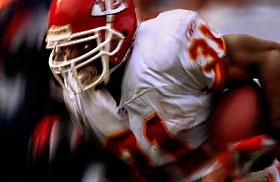 Hi and welcome to this edition of Workshop at the Ranch. The “box” of sports imagery is small when you think about it. I know, I know, there are tons of sports pictures all over the place, but it’s the variety of pictures that is lacking. There are so many techniques and industry innovations available to the sports photographer yet we seldom try something new. Yes, but my editor will fire me if I don’t come back with a solid shot. Yes, this is a concern. So should the sports photographer drift along shooting status quo or break out of the sports picture box and if you decide to break out how is that accomplished without loosing your job. Let me say that stepping out of the box will require some experimenting and failure before using a new technique or new equipment on the job. Each of the examples this article offers was first dealt with “off the job” before implemented at a game for a client. I have spent many hours at games that I was not assigned to. Little League games , Youth activities, High School and Intramural sports events are wonderful venues to learn something new before taking it to work. Always be prepared to execute a new technique well prior to Sundays big game.
Hi and welcome to this edition of Workshop at the Ranch. The “box” of sports imagery is small when you think about it. I know, I know, there are tons of sports pictures all over the place, but it’s the variety of pictures that is lacking. There are so many techniques and industry innovations available to the sports photographer yet we seldom try something new. Yes, but my editor will fire me if I don’t come back with a solid shot. Yes, this is a concern. So should the sports photographer drift along shooting status quo or break out of the sports picture box and if you decide to break out how is that accomplished without loosing your job. Let me say that stepping out of the box will require some experimenting and failure before using a new technique or new equipment on the job. Each of the examples this article offers was first dealt with “off the job” before implemented at a game for a client. I have spent many hours at games that I was not assigned to. Little League games , Youth activities, High School and Intramural sports events are wonderful venues to learn something new before taking it to work. Always be prepared to execute a new technique well prior to Sundays big game.
Hi and welcome to this edition of Workshop at the Ranch. The “box” of sports imagery is small when you think about it. I know, I know, there are tons of sports pictures all over the place, but it’s the variety of pictures that is lacking. There are so many techniques and industry innovations available to the sports photographer yet we seldom try something new. Yes, but my editor will fire me if I don’t come back with a solid shot. Yes, this is a concern. So should the sports photographer drift along shooting status quo or break out of the sports picture box and if you decide to break out how is that accomplished without loosing your job. Let me say that stepping out of the box will require some experimenting and failure before using a new technique or new equipment on the job. Each of the examples this article offers was first dealt with “off the job” before implemented at a game for a client. I have spent many hours at games that I was not assigned to. Little League games , Youth activities, High School and Intramural sports events are wonderful venues to learn something new before taking it to work. Always be prepared to execute a new technique well prior to Sundays big game.
You may not be a master of the technique or new equipment but at least you have experience and a good understanding of what to do to make good pictures. Many new techniques can be “LOW PERCENTAGE” shots compared to the status quo vertical picture of the quarterback with a 400mm f2.8 lens and motor drive, but don’t let the low percentage of good images discourage you. Volume is not the goal here …. UNIQUENESS is the goal. Something special and different, eye catching and innovative … that’s what we are after. So, get out of the box and get creative. Here are a few suggestions.
|
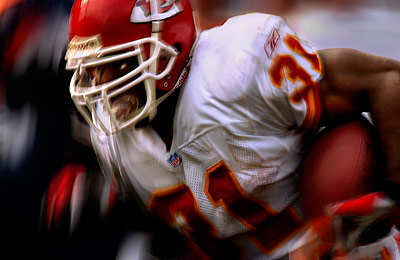 Image #1 The Slow Shutter Pan … The slow shutter speed pan is a good place to begin stepping out of the box. It requires only the equipment you already have, a camera and lens. Normally we think of sports photography as requiring a fast shutter speed of 1/500 or 1/1000. The slow shutter speed of 1/60, 1/30, 1/15 or even slower can create an effect of beautiful motion and color when an athlete runs by. As the player runs by me I Pan or follow as precisely as I can while the shutter clicks away. Areas of the subject that are hardly moving in the frame tend to be sharp while areas of the subject that move quickly tend to have motion. A football player’s number, helmet and face mask tend to move slower than his arms and legs. His helmet and team insignia will hold some sharpness while his arms and legs will have motion. The running back is an excellent subject for a pan. The goal is to keep steady on the subject and let the slow shutter speed do its job. The choice of shutter speed depends on how fast the athlete is running. High School athletes are slower than Professionals and race horses are slower than race cars. Experimentation will help you determine what shutter speed works for different sports. I like to shoot slow with football players, 1/60 is common for most but I really slow it down to 1/30 or even 1/15. This image was shot at 1/30. I made several frames on several different plays. I accomplished one strong image out about 20 frames. Low Percentage yes, but the end result was a different picture. Remember, something in the picture must be sharp in order to hold the picture together for the viewer to settle their eye on and thus be successful. Image #1 The Slow Shutter Pan … The slow shutter speed pan is a good place to begin stepping out of the box. It requires only the equipment you already have, a camera and lens. Normally we think of sports photography as requiring a fast shutter speed of 1/500 or 1/1000. The slow shutter speed of 1/60, 1/30, 1/15 or even slower can create an effect of beautiful motion and color when an athlete runs by. As the player runs by me I Pan or follow as precisely as I can while the shutter clicks away. Areas of the subject that are hardly moving in the frame tend to be sharp while areas of the subject that move quickly tend to have motion. A football player’s number, helmet and face mask tend to move slower than his arms and legs. His helmet and team insignia will hold some sharpness while his arms and legs will have motion. The running back is an excellent subject for a pan. The goal is to keep steady on the subject and let the slow shutter speed do its job. The choice of shutter speed depends on how fast the athlete is running. High School athletes are slower than Professionals and race horses are slower than race cars. Experimentation will help you determine what shutter speed works for different sports. I like to shoot slow with football players, 1/60 is common for most but I really slow it down to 1/30 or even 1/15. This image was shot at 1/30. I made several frames on several different plays. I accomplished one strong image out about 20 frames. Low Percentage yes, but the end result was a different picture. Remember, something in the picture must be sharp in order to hold the picture together for the viewer to settle their eye on and thus be successful.
|
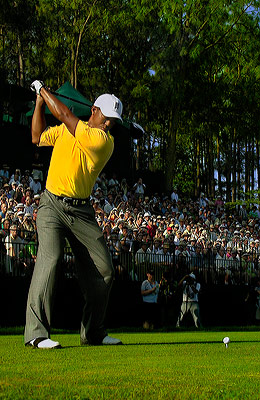 Image #2 New Technology … The industry is flooded with new technology of all shapes and sizes. I have been quite successful using the Nikon Coolpix 8800 consumer camera. I cover a golf tournament using a variety of gear but the Coolpix with it’s silent shutter makes it possible to capture quality images of the golfer at the top of their backswing. Impossible to accomplish at at close range the top of the backswing is seldom seen in golf photography. Simple to execute but defiantly unique when published the backswing picture of any golfer tends to find it’s way into publication. The Coolpix 8800 is also very stealth and unassuming to the golfer and caddie because of it’s lack of professional size. This image of Tiger Woods was easily made with the Coolpix while other photographers had to settle for the traditional golf swing image of the club resting on Tiger’s shoulder. Remember, using a new camera takes time to master so practice off the tee before heading to the US Open. Image #2 New Technology … The industry is flooded with new technology of all shapes and sizes. I have been quite successful using the Nikon Coolpix 8800 consumer camera. I cover a golf tournament using a variety of gear but the Coolpix with it’s silent shutter makes it possible to capture quality images of the golfer at the top of their backswing. Impossible to accomplish at at close range the top of the backswing is seldom seen in golf photography. Simple to execute but defiantly unique when published the backswing picture of any golfer tends to find it’s way into publication. The Coolpix 8800 is also very stealth and unassuming to the golfer and caddie because of it’s lack of professional size. This image of Tiger Woods was easily made with the Coolpix while other photographers had to settle for the traditional golf swing image of the club resting on Tiger’s shoulder. Remember, using a new camera takes time to master so practice off the tee before heading to the US Open.
|
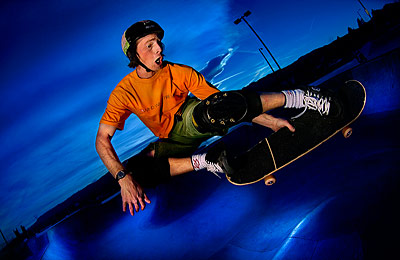 Image #3 Off Camera Flash … New Technology also comes into play with Off Camera Flash. The use of off camera flash was mind boggling until recently. Off camera flash units like the Nikon SB800 Speedlight offers breakthrough technology with regards to portability, TTL power exposures and the use of fast sync shutter speeds. This skateboarder was doing his tricks at a typical skateboard park with grey concrete, lamp posts and the ever present parking lot. By underexposing the image and then powering up my off camera SB800 Speedlight I was able to eliminate all the “skateboard park clutter. Furthermore, by using a cool White Balance of 3600K and then placing a warming gel over the front of the SB800 I was able to create a very stylized image with powerful color and drama. Remember, off camera flash is not just for portraits any more. Image #3 Off Camera Flash … New Technology also comes into play with Off Camera Flash. The use of off camera flash was mind boggling until recently. Off camera flash units like the Nikon SB800 Speedlight offers breakthrough technology with regards to portability, TTL power exposures and the use of fast sync shutter speeds. This skateboarder was doing his tricks at a typical skateboard park with grey concrete, lamp posts and the ever present parking lot. By underexposing the image and then powering up my off camera SB800 Speedlight I was able to eliminate all the “skateboard park clutter. Furthermore, by using a cool White Balance of 3600K and then placing a warming gel over the front of the SB800 I was able to create a very stylized image with powerful color and drama. Remember, off camera flash is not just for portraits any more. |
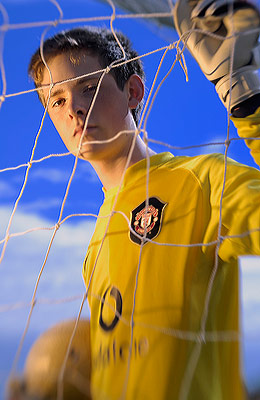 Image #4 Take a chance … The Lensbabie is a great tool. It will take some time to master but is worth the money. Primarily used on stationary subjects the Lensbabie has an extremely narrow “Sweet Spot” of focus that when used effectively can make a very interesting picture. So far, I have only used the Lensbabie with some portraiture. I adjust the sweet spot on my subjects eye and allow the soft blurred fall off to occur over the remainder of the picture. I use the f4 ring with my Lensbabie II. The lens coating are not the same on a Lensbabie as on Nikon or Canon lenses so be aware of the color shift that will occur and adjust your white balance accordingly. Remember, this “drastic” uniqueness will be useful and appreciated only if it is used sparingly with your editor. If too many of your portraits have this very stylized look it becomes ordinary in a hurry. Image #4 Take a chance … The Lensbabie is a great tool. It will take some time to master but is worth the money. Primarily used on stationary subjects the Lensbabie has an extremely narrow “Sweet Spot” of focus that when used effectively can make a very interesting picture. So far, I have only used the Lensbabie with some portraiture. I adjust the sweet spot on my subjects eye and allow the soft blurred fall off to occur over the remainder of the picture. I use the f4 ring with my Lensbabie II. The lens coating are not the same on a Lensbabie as on Nikon or Canon lenses so be aware of the color shift that will occur and adjust your white balance accordingly. Remember, this “drastic” uniqueness will be useful and appreciated only if it is used sparingly with your editor. If too many of your portraits have this very stylized look it becomes ordinary in a hurry. |
Well, go on ………………… Get out of the box. There is a whole new world out there just beyond your 400mm f2.8 lens. Try something new at a game that does not count. Be ready for many low percentage shots, but when you get one, just ONE Great Picture it’s a great day!
See you next time on Workshop at the Ranch ……………………………… Adios. Dave
![]() Hi and welcome to this edition of Workshop at the Ranch. The “box” of sports imagery is small when you think about it. I know, I know, there are tons of sports pictures all over the place, but it’s the variety of pictures that is lacking. There are so many techniques and industry innovations available to the sports photographer yet we seldom try something new. Yes, but my editor will fire me if I don’t come back with a solid shot. Yes, this is a concern. So should the sports photographer drift along shooting status quo or break out of the sports picture box and if you decide to break out how is that accomplished without loosing your job. Let me say that stepping out of the box will require some experimenting and failure before using a new technique or new equipment on the job. Each of the examples this article offers was first dealt with “off the job” before implemented at a game for a client. I have spent many hours at games that I was not assigned to. Little League games , Youth activities, High School and Intramural sports events are wonderful venues to learn something new before taking it to work. Always be prepared to execute a new technique well prior to Sundays big game.
Hi and welcome to this edition of Workshop at the Ranch. The “box” of sports imagery is small when you think about it. I know, I know, there are tons of sports pictures all over the place, but it’s the variety of pictures that is lacking. There are so many techniques and industry innovations available to the sports photographer yet we seldom try something new. Yes, but my editor will fire me if I don’t come back with a solid shot. Yes, this is a concern. So should the sports photographer drift along shooting status quo or break out of the sports picture box and if you decide to break out how is that accomplished without loosing your job. Let me say that stepping out of the box will require some experimenting and failure before using a new technique or new equipment on the job. Each of the examples this article offers was first dealt with “off the job” before implemented at a game for a client. I have spent many hours at games that I was not assigned to. Little League games , Youth activities, High School and Intramural sports events are wonderful venues to learn something new before taking it to work. Always be prepared to execute a new technique well prior to Sundays big game. 





